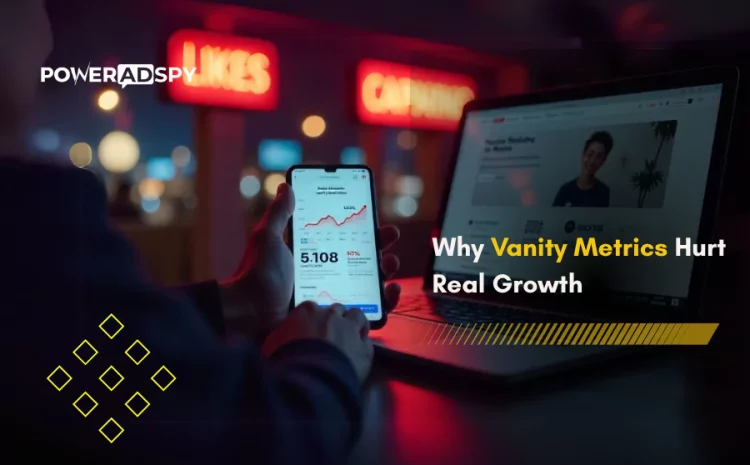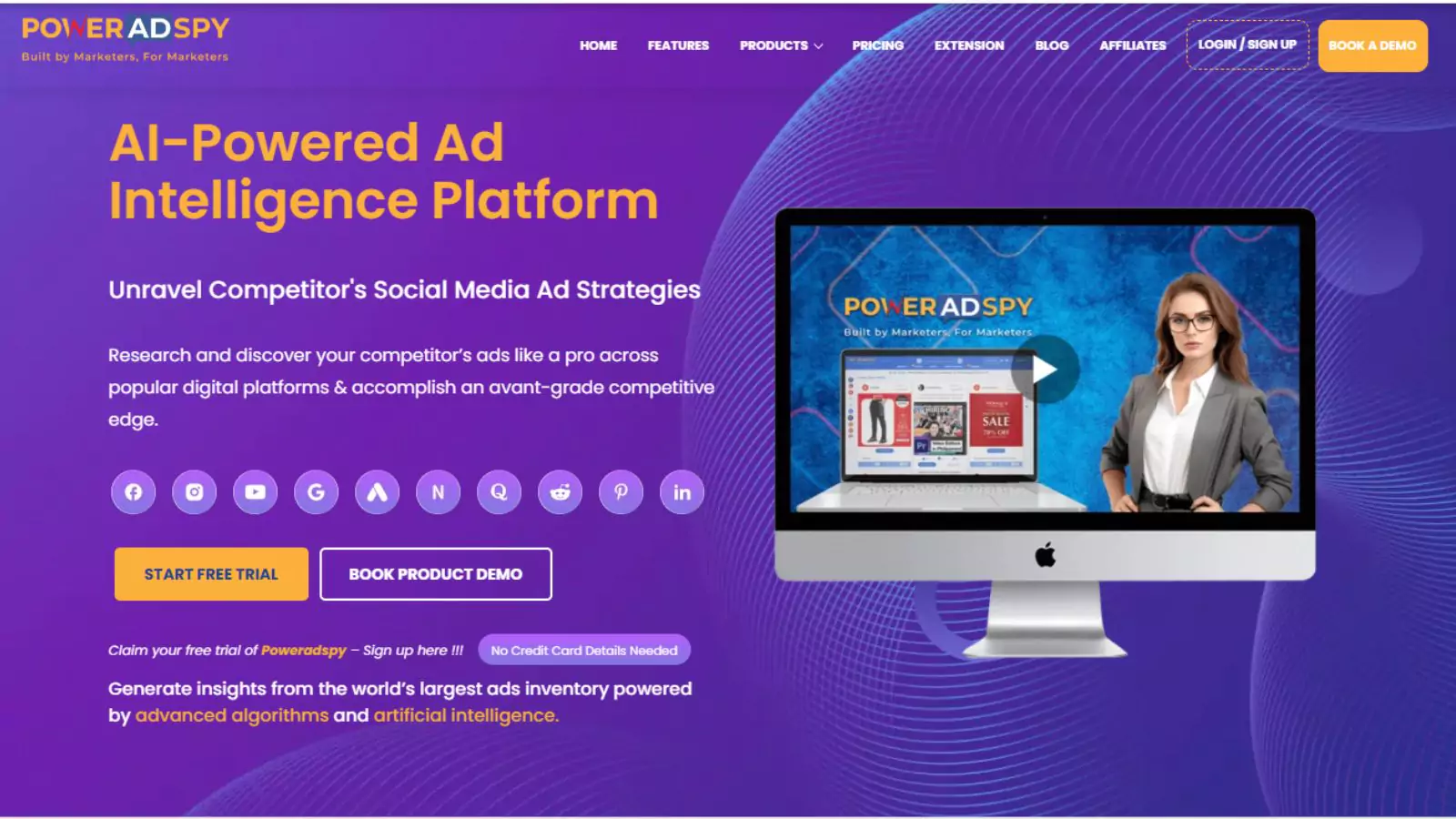Why Vanity Metrics Are Hurting Your Real Growth?
According to a survey, 73% of marketers track social media performance using metrics like followers, likes, and impressions. But here’s the catch: many of these numbers don’t actually contribute to business growth. They’re what marketers call vanity metrics.
They look great on paper but rarely offer meaningful insights. And if you’re not careful, they can distort your strategy and steer you away from results that actually matter.
Before diving into what you should track, it’s essential to understand what vanity metrics are and why they can be misleading.
Listen To The Podcast Now!
What Are Vanity Metrics?
Let’s begin with a simple breakdown. Vanity metrics are the numbers that grab attention but offer little direction. They include followers, likes, shares, and impressions data points that are easy to measure and even easier to celebrate, yet don’t necessarily tie into your core business objectives.
These metrics serve more as a highlight reel than a performance report. They may give a quick sense of reach or awareness, but they rarely tell you what your audience is actually doing. Are they clicking? Are they becoming customers?
So, if you’re still wondering what vanity metrics are, think of them as metrics that focus more on perception than performance. They reflect activity, not impact.
But it’s important to note, vanity metrics aren’t inherently useless. Their value depends entirely on the context.
Vanity Metrics Definition: Context Changes Everything
At the start, every metric holds potential value, it’s how we interpret and use them that can turn them into vanity data. A number becomes “vanity” the moment it stops supporting your goals. That’s why the definition of vanity metrics can’t be one-size-fits-all.
For instance, a sudden increase in social media followers might seem like growth. But if those new followers never engage with your content, never visit your website, or never buy from you, then the metric becomes more of a distraction than a milestone.
Likewise, a high number of ad impressions might catch your eye until you realize there’s little to no click-through rate or engagement behind it. In that case, you’re measuring visibility, not effectiveness.
So, when thinking about vanity metrics, it all comes down to relevance. A metric is only useful if it informs your next move or ties back to your objectives.
And yet, even with this knowledge, many marketers still chase these metrics. Why? Let’s explore the psychology behind it.
The Psychology Behind Vanity Metrics
It’s not just marketers who are drawn to vanity metrics. Stakeholders, executives, and even clients often see big numbers and associate them with success. That instant gratification—a viral tweet or a five-figure reach—is hard to ignore.
Meaningful marketing results come from a consistent strategy and gradual improvement. And relying on surface-level numbers keeps teams in a cycle of chasing what looks good rather than what works.
So, how do we move past the vanity? Let’s examine what meaningful metrics actually look like.
Actionable Metrics Vs Vanity Metrics: Spot The Difference
Now that we’ve established what vanity metrics are and why they can mislead your strategy, let’s contrast them with something far more valuable: actionable metrics.
While vanity metrics may offer a quick snapshot of activity, actionable metrics reveal the full picture. They don’t just show what happened, they help explain why it happened and what you can do about it. That’s the real difference.
Actionable metrics are tied directly to outcomes. They allow you to make decisions, optimize campaigns, improve user journeys, and ultimately grow your business. These are the numbers that carry weight in performance reviews, campaign adjustments, and forecasting. They tell a story you can act on, not just admire.
Here’s how they stack up against each other:
-
Follower Count vs. Engagement Rate
Seeing your followers grow might be satisfying, but unless those followers regularly interact with your content, the number is just that: a number. Engagement rate, on the other hand, shows how actively your audience connects with your content over time. It reveals how well your message resonates and whether your content strategy is working.
-
Impressions vs. Conversion Rate
High ad impressions may look promising, but they don’t confirm effectiveness. If your goal is to drive traffic, leads, or sales, impressions alone won’t help. Conversion rate tells you how many people took the desired action after seeing your ad, providing a much clearer indication of performance.
-
Page Views vs. Bounce Rate & Session Duration
Page views are only part of the story. Without understanding how long users stayed or whether they explored further, the metric lacks depth. Bounce rate and session duration offer insight into user intent, interest, and the quality of your content experience.
-
Likes & Shares vs. Click-Through Rate (CTR)
It’s easy to assume that a post with lots of likes or shares is successful. But unless it leads users to take action, like clicking on a link or filling out a form, it’s more of a vanity win than a business win. A good click-through rate helps measure how persuasive your messaging is in driving users to your next step.
To determine if a metric is actionable, ask yourself a simple question:
“Does this number help me decide what to do next?”
If it doesn’t guide your next move, it’s likely not the metric you should be focusing on.
This shift, from reporting numbers to reading insights, is where your data starts working for you. You stop reacting to spikes in superficial stats and start responding to patterns that genuinely impact your bottom line.
And nowhere is this shift more important than in social media marketing, where vanity metrics tend to dominate conversations but rarely drive conversions.
Let’s dive deeper into that.
Also Read
Top 5 Social Media Metrics To Track As A Business Marketer
Good Click Through Rate: How to Get Users Clicking Your Way
Vanity Metrics In Social Media: When Engagement Becomes Deceptive
Social media platforms offer a wealth of data and social media metrics like likes, comments, shares, followers, and impressions. While these metrics may look impressive at first glance, they can easily mislead you. Here’s why:
1. High Engagement Doesn’t Always Equal Success
- A post with thousands of likes or shares might seem like a hit, but that’s not always the case.
- What if those users didn’t click the link, visit your website, or take any further action? These numbers are simply surface-level, giving you a false sense of accomplishment.
2. Vanity Metrics Focus On Numbers, Not Actions
- Vanity metrics such as likes, shares, and follower counts show how many people interacted with your post but fail to indicate whether those interactions led to meaningful actions.
- For example, gaining followers looks good on paper, but if those followers are inactive and don’t engage further with your content, then they’re just a hollow number.
3. Quality Of Engagement Is More Important Than Quantity
- Instead of obsessing over how many likes or comments a post gets, focus on engagement that directly impacts your goals.
- Metrics like click-through rates, profile visits, story replies, and saved posts give you a much clearer idea of whether your audience is genuinely interested in what you’re offering.
4. The Link Between Engagement And Business Goals
- Vanity metrics often fail to connect social media engagement to tangible business outcomes such as conversions or revenue growth.
- High engagement doesn’t always translate into customer acquisition. You need to analyze how those interactions help you meet key performance indicators (KPIs).
5. The Danger Of Relying On Vanity Metrics
- Blindly chasing metrics like likes and shares without considering the bigger picture can lead to misguided strategies and missed opportunities.
- It can distort your approach, encouraging you to prioritize popularity over actual performance and business results.
6. To Get Accurate Insights, You Need the Right Tools
- Tracking vanity metrics can give you a skewed perception of your social media performance.
- To gain a more accurate picture, use analytics tools that provide actionable insights like the number of profile actions, website visits, and other key metrics that align with your business objectives.
By focusing on the quality of engagement rather than just chasing vanity metrics, you’ll have a better chance of making strategic decisions that contribute to your goals. To achieve your desired goal, tracking is necessary not only for you but also for your competitors. This is why you can try the Ad Spy tool for competitor analysis. Let us explore how tools and intelligence tools like PowerAdSpy can be a game changer.
How PowerAdSpy Helps Competitor Analysis
PowerAdSpy doesn’t just show you flashy ad stats. It gives you real-time data from across platforms, revealing what kinds of content generate action, not just attention.
Instead of getting distracted by high-view ads, with PowerAdSpy, you can identify creatives with strong CTRs or engagement rates. This shift is essential if you want to understand what actually influences your audience across 9 social media platforms. And when you bring ad intelligence software into the mix, things get even more insightful. Let us explore some of its advanced features:
Filter by Ad Positions
With PowerAdSpy, you’re enabled to segment social ads based on their positions, such as News Feed or Side Location. This helps you analyze performance across placements and discover which ad spots work best for your niche and conversion goals.
Complete Visibility
PowerAdSpy allows you to explore live ad posts directly from the platform, giving you real-time access to ad performance. This helps you cross-check actual engagement and better understand how audiences are interacting with the content.
Data of Millions of Ads from 100+ Countries
PowerAdSpy helps you access a vast and ever-growing database of ads from over 100 countries. This allows you to discover fresh, trending, and successful ad creatives with just a few clicks, as new entries are added daily.
Narrow Down Your Searches
It enables you to refine your research by filtering ads using niche-specific keywords, advertiser names, or competitor domains. You can even explore the complete ad activity of top-performing competitors to get deeper insights into their strategy.
Bookmark the Best Ads
PowerAdSpy allows you to save standout ad concepts into your personalized ad inventory. This helps you keep track of promising ideas without needing to search for them again later.
Powerful Search Algorithm
It helps you find exactly what you’re looking for by enabling ad searches through relevant keywords, phrases, and terms. You can sort the results by metrics like date, likes, shares, or comments to identify top-performing ads in seconds.
Engagement-Oriented Details
PowerAdSpy provides detailed insights into social engagement across ads, helping you understand which creatives resonate most within your niche. These details can guide you in shaping content that actually connects.
Combination of Video and Image Ads
It enables you to explore both image and video ad creatives, giving you a clearer picture of which format your audience is responding to. PowerAdSpy also allows you to download video ads that align with your campaign goals.
GEO-Targeted Insights
With access to millions of ads, PowerAdSpy helps you uncover geo-targeting strategies used by competitors. This allows you to identify regions where interest in similar products or services is already high.
Call-to-Action Based Sorting
PowerAdSpy enables you to analyze ads by specific calls to action. This helps you determine which CTAs are driving engagement and conversions within your niche, making it easier to shape your own campaigns around what works.
Try PowerAdSPy and take your strategy to the next level!
Now you have the tool, it’s time to know what vanity metrics are in content marketing.
Vanity Metrics In Content Marketing: Views Without Value?
Content marketers often rely on pageviews and time on page. But views alone don’t guarantee engagement or impact.
A blog post with 10,000 views sounds great—until you realize most users bounced within 15 seconds. Instead, prioritize:
- Scroll depth
- Session duration
- CTA click rate
These tell you whether your content is resonating and guiding users toward meaningful actions. When tracked properly, even simple metrics can turn powerful.
Just as with search performance, context always adds depth.
Vanity Metrics in Search Marketing: Rankings Aren’t Results
SEO metrics like keyword rankings and traffic volume are easy to brag about. But unless they lead to engagement or conversions, they’re just digital dust.
A better approach is to track:
- Organic conversion rate
- Time to conversion from SEO traffic
- ROI from SEO campaigns
These metrics align with actual goals. Rankings may show visibility, but conversions show value.
This same principle holds true in brand management too.
Vanity Metrics In Brand Management: More Than Just Reach
It’s tempting to use reach or sentiment scores as evidence of brand strength. But reach means little if it doesn’t drive recognition or loyalty.
Instead, look toward:
- Brand recall studies
- Net Promoter Score (NPS)
- Share of voice in key markets
True brand equity grows from how people experience and talk about your brand, not just how often they see it.
But what about PR? Let’s wrap this section with one final context-heavy domain.
Vanity Metrics in PR: Mentions Aren’t the Metric
Media mentions and publication count might feel impressive, but they don’t guarantee audience impact. Instead of stopping there, evaluate:
- Referral traffic from media coverage
- Audience sentiment post-coverage
- Engagement from PR-driven leads
These numbers reveal if your efforts actually shifted perception or behavior—not just headlines.
Once you align your data with business outcomes, everything becomes more strategic.
How To Avoid Falling for Vanity Metrics
To steer clear of vanity traps, ask yourself this every time you look at a metric:
- Does this number align with a specific business goal?
- Can I take action based on this?
- Is this metric consistent across different sources?
If the answer is no, you may be looking at vanity.
This mindset shift changes how you measure, report, and optimize marketing across all channels.
Final Thoughts
Vanity metrics may look appealing, but without real impact, they’re just noise. To build a performance-driven marketing strategy, focus on actionable data—metrics that tell you something meaningful and guide your next move.
So next time you see a spike in followers or impressions, pause. Ask what that number means. Ask if it moves your business forward.
If the answer is yes, you’re no longer chasing vanity.
You’re tracking value.
FAQS
Q: Are all engagement metrics considered vanity metrics?
Not always. Some engagement metrics, like comments, saves, or shares, can indicate real interest or intent. The value depends on the quality of engagement and its relation to your goals.
Q: Why do stakeholders still prioritize vanity metrics?
Because they’re easy to understand, visually impressive, and give an illusion of success. They often provide instant gratification, which appeals to non-technical audiences.









